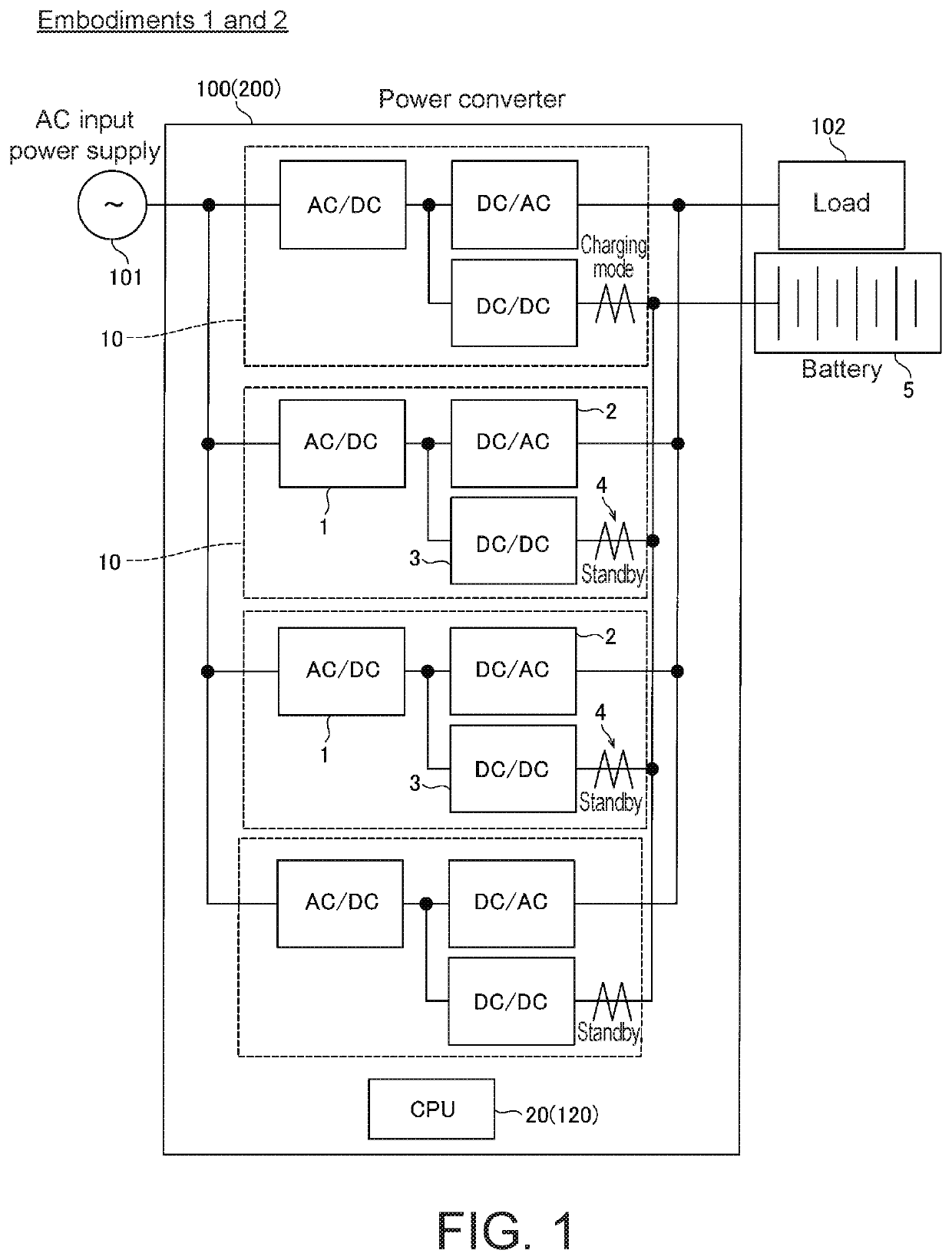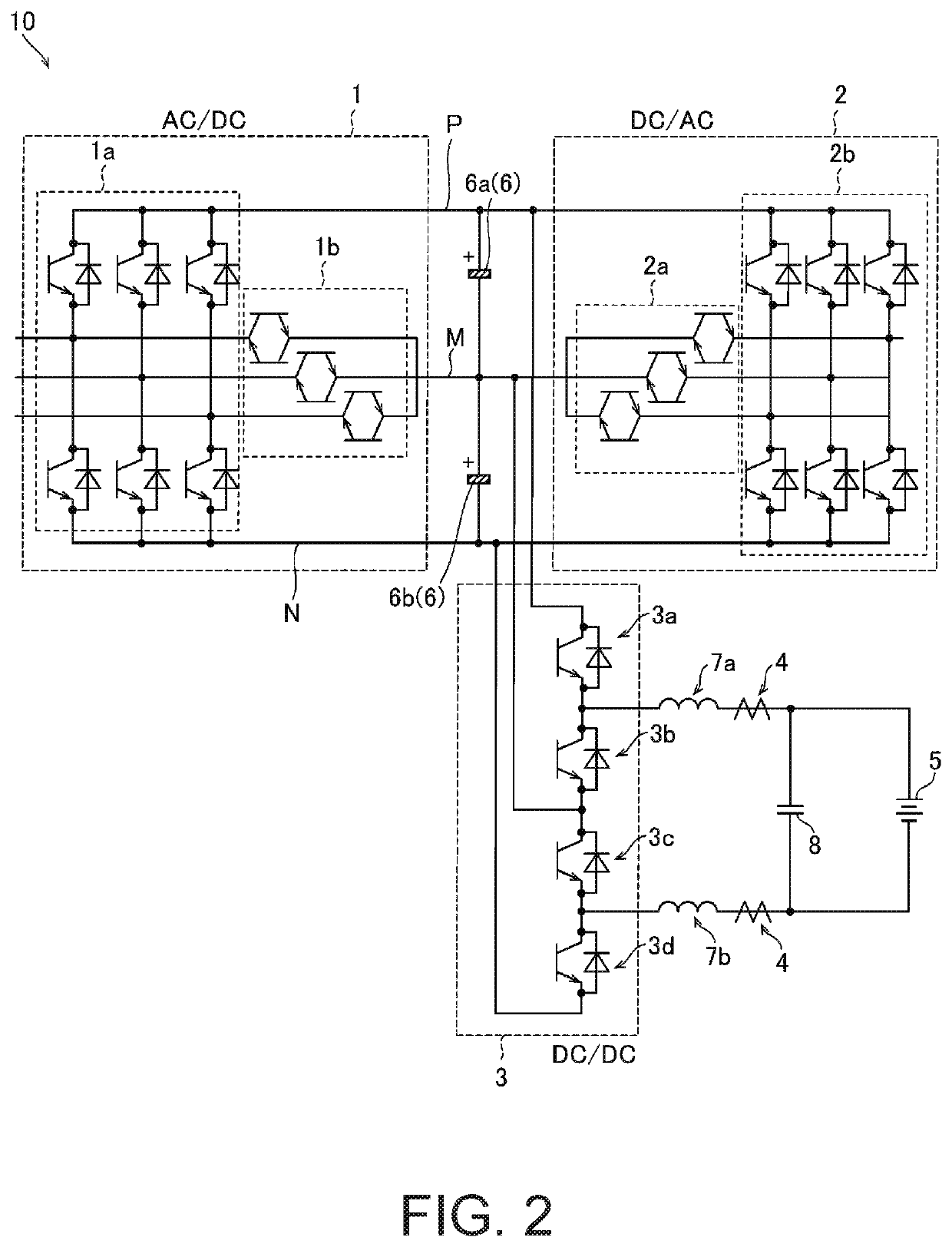Power converter
a power converter and converter technology, applied in the field of power converters, can solve the problems of difficult accurate use, low resolution of current detectors with large magnitude, and low resolution of current detectors, so as to facilitate the change of the amount of current, the effect of detecting the current flow and reducing the difficulty of accuracy
- Summary
- Abstract
- Description
- Claims
- Application Information
AI Technical Summary
Benefits of technology
Problems solved by technology
Method used
Image
Examples
embodiment 1
Effects of Embodiment 1
[0051]Embodiment 1 makes it possible to achieve the following advantageous effects.
[0052]As described above, in Embodiment 1 the power converter 100 is configured to include the battery 5 that is charged by a subset of DC / DC converters 3 among the DC / DC converters 3 of the plurality of power conversion units 10, as well as the CPU 20 that controls the DC / DC converters 3 of the plurality of power conversion units 10. Here, the charge current that flows to a single current detector 4 takes a value equal to the charge current that flows to the battery 5 divided by the number of power conversion units 10 (DC / DC converters 3) being used for charging. Thus, charging the battery 5 using a subset of DC / DC converters 3 among the DC / DC converters 3 of the plurality of power conversion units 10 makes it possible to increase the charge current that flows to a single current detector 4 in comparison to if all of the DC / DC converters 3 were used for charging. As a result, e...
embodiment 2
Effects of Embodiment 2
[0062]Embodiment 2 makes it possible to achieve the following advantageous effects.
[0063]As described above, in Embodiment 2 the power converter 200 is configured such that the CPU 120 selects the DC / DC converters 3 in the subset that charges the battery 5 in order starting from the DC / DC converter 3 with the highest priority ranking, as determined on the basis of the cumulative operation times of the DC / DC converters 3, among the DC / DC converters 3 of the plurality of power conversion units 10. This makes it possible to prevent DC / DC converters 3 with longer cumulative operation times and a greater degree of degradation from being used to charge the battery 5. This, in turn, makes it possible to inhibit degradation of (damage to) the DC / DC converters 3.
[0064]The rest of the effects of Embodiment 2 are the same as in Embodiment 1.
modification examples
[0065]It should be noted that in all respects, the embodiments described above are only examples and do not limit the present invention in any way. The scope of the present invention is defined by the claims, not by the descriptions of the embodiments above. Furthermore, the scope of the present invention also includes all changes (modification examples) made within the scope of the claims and their equivalents.
[0066]For example, although in Embodiments 1 and 2 above the number of active DC / DC converters 3 (DC power converters) in the subset was described as being changed on the basis of the detected values from the current detectors 4 as an example, the present invention is not limited to this example. For example, the number of active DC / DC converters 3 (DC power converters) in the subset may be changed on the basis of the current flowing to the load 102 from the DC / AC converters 2 (AC power converters).
[0067]More specifically, as illustrated in FIG. 4, a power converter 300 inclu...
PUM
 Login to View More
Login to View More Abstract
Description
Claims
Application Information
 Login to View More
Login to View More - R&D
- Intellectual Property
- Life Sciences
- Materials
- Tech Scout
- Unparalleled Data Quality
- Higher Quality Content
- 60% Fewer Hallucinations
Browse by: Latest US Patents, China's latest patents, Technical Efficacy Thesaurus, Application Domain, Technology Topic, Popular Technical Reports.
© 2025 PatSnap. All rights reserved.Legal|Privacy policy|Modern Slavery Act Transparency Statement|Sitemap|About US| Contact US: help@patsnap.com



